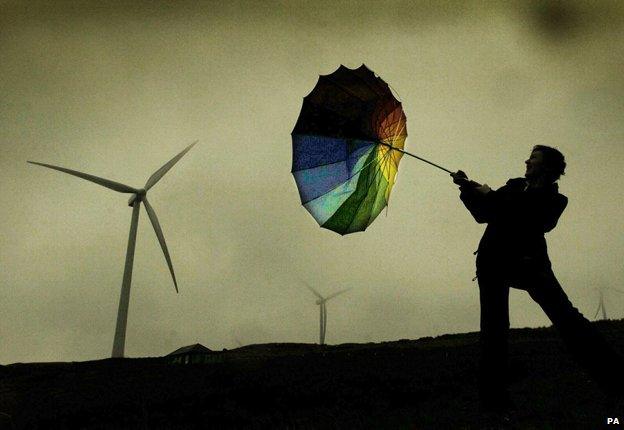Who, what, why: What happens to wind turbines in a storm?
- Published

Two years ago video footage of a wind turbine catching fire and breaking up in Ardrossan, Ayrshire, was widely circulated. So what does happen to wind farms on a very windy day?
Turbines do occasionally have to be shut off in very high winds, but usually at speeds higher than the current storm in the south of the UK.
Failure to do so can lead to an incident like the one at Ardrossan. That was blamed on a fault that stopped the head of the turbine pointing in the correct direction and another fault with the brakes.
During dangerously high wind, the blades on turbines are supposed to be "feathered", external - twisted so they no longer catch the wind and rotate.
The current storm has already destroyed one turbine in Devon. Tim Kirby, managing director of Ecogen, admitted there might be some problems for smaller turbines but not for typical commercial farms.
"Big ones tend to stand anything," he says. "We very rarely see high-wind 'stops'. Most of them have a variety of automatic shutdown speeds."
One type of shutdown trigger would be wind over a certain average speed measured over 10 minutes. Another type of shutdown is triggered by gusts, although these would be more than 100mph, much higher than the current storm.
Another independent renewables firm, Ecotricity, said it was operating at roughly two thirds of capacity. Of its 55 turbines, many in East Anglia, only six were offline and none due to excessive wind. The firm says its turbines only shut down with continuous wind speeds of between 62mph and 76mph, depending on make and model.
And the current winds have not produced a record-breaking amount of electricity. Wind provision was quite high on Sunday but is normal today, says Jennifer Webber, director of external affairs of Renewable UK, the renewable energy trade association.
The National Grid said that from 09:30 to 10:00 GMT wind generated 3,110MW, which accounted for 8.1% of total energy needs. The record for a half-hour period was in September with 5,700MW, 17% of demand.
Of course, the current storm is only seriously affecting the south of the UK and wind farms are disproportionately located in the north, particularly Scotland.
Reporting by Olivia Sorrel-Dejerine and Finlo Rohrer
Follow @BBCNewsMagazine, external on Twitter and on Facebook, external